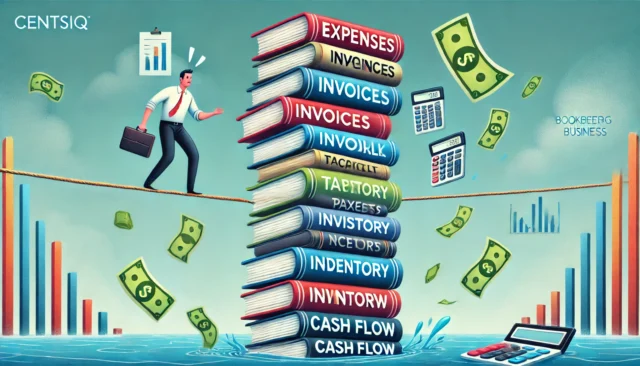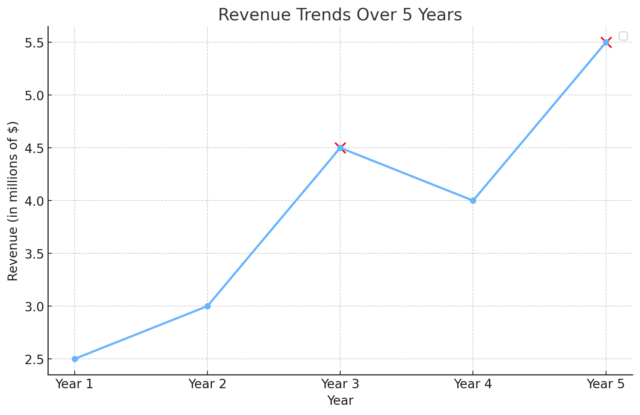
As we approach the dawn of 2025, it’s time for small business owners to think beyond mere resolutions and set their sights on transformative financial goals. At CentsIQ, we believe that the key to small business success lies in strategic planning, smart financial management, and a dash of entrepreneurial spirit. This comprehensive guide will walk you through the process of setting, pursuing, and achieving game-changing financial goals for your small business in the coming year.
Table of Contents
- 1 Why Financial Goals for Your Small Business in 2025 Matter?
- 1.0.1 Step 1: Dream Big, But Keep It Specific
- 1.0.2 Step 2: Reverse Engineer Your Financial Success
- 1.0.3 Step 3: Make Your Goals SMART (Because Dumb Goals Are So Last Year)
- 1.0.4 Step 4: Prioritize Like a Pro (Because You Can’t Do Everything at Once)
- 1.0.5 Step 5: Write It Down (In Permanent Marker)
- 1.0.6 Step 6: Get an Accountability Buddy (Or a Really Judgmental Pet)
- 1.0.7 Step 7: Stay Flexible (Like a Yoga Instructor, But With Money)
- 1.0.8 Step 8: Celebrate Like You Just Won the Lottery (Even If It’s Just a Small Scratch-Off)
- 1.0.9 Conclusion: Your Roadmap for Establishing Financial Goals for Your Small Business in 2025
Why Financial Goals for Your Small Business in 2025 Matter?
Before we dive into the nitty-gritty of goal setting, let’s talk about why it’s crucial for your small business. In the ever-evolving landscape of entrepreneurship, having clear financial objectives can:
- Provide direction and focus for your business efforts
- Help you allocate resources more effectively
- Motivate you and your team to strive for growth
- Enable better decision-making in various aspects of your business
- Measure progress and celebrate achievements along the way
Now that we’ve established the importance of financial goal setting, let’s embark on this money-making journey together!
Step 1: Dream Big, But Keep It Specific
The first rule of the small business goal-setting club is to dream big while keeping your feet firmly planted in reality. Vague aspirations like “I want to grow my business” are about as useful as a screen door on a submarine. Instead, let’s craft goals that are as specific as your grandma’s secret recipe.
Examples of Specific Financial Goals for Small Businesses:
- “I will increase my handmade soap company’s monthly revenue from $5,000 to $7,500 by December 31, 2025.”
- “My freelance graphic design business will acquire 10 new long-term clients by the end of Q3 2025.”
- “I’ll reduce my vintage clothing store’s operational costs by 15% without sacrificing quality by July 2025.”
- “How to plan your finances in 2025?”
- “What is a 5 year financial strategy?”
Remember, your goals should make you feel a mix of excitement and nervous anticipation. If they don’t give you a little flutter in your entrepreneurial stomach, you might not be aiming high enough!
Step 2: Reverse Engineer Your Financial Success
Now that you’ve got your big, audacious goal, it’s time to break it down into manageable chunks. Think of it as creating a treasure map to your financial El Dorado.
How to Break Down Your Financial Goals:
- Start with your end goal and work backwards.
- Identify major milestones along the way.
- Break these milestones into quarterly objectives.
- Determine monthly targets to keep you on track.
Let’s say your goal is to open a second location for your wildly successful artisanal pickle shop (because one can never have too many pickles). Your 2025 objectives might look something like this:
- Q4 2025: Grand opening of the new location
- Q3 2025: Hire and train staff for the new shop
- Q2 2025: Secure and renovate the new space
- Q1 2025: Research locations and secure financing
By breaking it down, you transform a daunting task into a series of achievable steps. It’s like eating an elephant – one bite at a time (though we’d recommend sticking to pickles).
Step 3: Make Your Goals SMART (Because Dumb Goals Are So Last Year)
You’ve probably heard of SMART goals before, but let’s refresh our memory and apply this concept to your small business financial objectives. SMART stands for Specific, Measurable, Achievable, Relevant, and Time-bound.
Turning Good Goals into SMART Goals:
- Specific: Instead of “increase sales,” try “increase online sales of our signature hot sauce by 30%.”
- Measurable: Establish clear metrics, like “acquire 50 new B2B customers” or “reduce inventory costs by $1,000 per month.”
- Achievable: Push yourself, but keep it realistic. “Double revenue” might be a stretch, but “increase revenue by 25%” could be just right.
- Relevant: Ensure your goal aligns with your overall business strategy and values.
- Time-bound: Set a clear deadline, like “by December 31, 2025” or “within the first six months of the year.”
Example of a SMART Financial Goal:
“I will increase my pet grooming business’s profit margin from 15% to 20% by implementing cost-saving measures and raising prices strategically, achieving this goal by September 30, 2025.”
Step 4: Prioritize Like a Pro (Because You Can’t Do Everything at Once)
As a small business owner, you’re probably used to wearing many hats. But when it comes to financial goals, trying to do everything at once is like juggling flaming torches while riding a unicycle – impressive, but likely to end in disaster.
How to Prioritize Your Financial Goals:
- List all your potential goals for 2025.
- Evaluate each goal based on its potential impact and feasibility.
- Choose 3-5 major financial objectives to focus on.
- Rank these goals in order of importance or chronological necessity.
Example of Prioritized Financial Goals for a Small Bakery:
- Increase monthly revenue from $10,000 to $15,000 by expanding our wholesale accounts.
- Reduce food waste costs by 25% through better inventory management.
- Launch an e-commerce platform to sell our signature cookies nationwide.
- Set aside 10% of profits each month for a future equipment upgrade fund.
By focusing on a few key areas, you’ll be able to channel your energy and resources more effectively, increasing your chances of success.
Step 5: Write It Down (In Permanent Marker)
Goals that stay in your head are like invisible friends – fun to think about, but not very helpful in the real world. It’s time to make your financial objectives tangible by writing them down and keeping them visible.
Creative Ways to Display Your Financial Goals:
- Create a vision board for your office with your goals and inspiring images.
- Write your main objective on a sticky note and place it on your computer monitor.
- Set up a goal tracking spreadsheet and review it weekly.
- Use the centsiq.com goal tracking feature to monitor your progress digitally.
The key is to keep your goals front and center, serving as a constant reminder of what you’re working towards.
Step 6: Get an Accountability Buddy (Or a Really Judgmental Pet)
They say it takes a village to raise a child, and the same could be said for achieving your financial goals. Having someone to hold you accountable can significantly increase your chances of success.
Finding the Right Accountability Partner:
- A fellow small business owner who understands your challenges
- A mentor in your industry who can offer guidance
- A financial advisor who can provide expert insights
- Your business partner or a trusted employee
If human interaction isn’t your thing, consider using technology to keep yourself on track. The centsiq.com platform offers tools and reminders to help you stay focused on your financial objectives.
Step 7: Stay Flexible (Like a Yoga Instructor, But With Money)
In the world of small business, change is the only constant. Markets shift, customer preferences evolve, and sometimes, a global pandemic decides to shake things up. That’s why flexibility is crucial when pursuing your financial goals.
Tips for Staying Adaptable:
- Review your goals quarterly to ensure they’re still relevant.
- Be prepared to pivot your strategies if something isn’t working.
- Celebrate small wins along the way to maintain motivation.
- Learn from setbacks and use them to refine your approach.
Remember, flexibility isn’t about abandoning your goals; it’s about finding new paths to reach them when the original route is blocked.
Step 8: Celebrate Like You Just Won the Lottery (Even If It’s Just a Small Scratch-Off)
Too often, small business owners are so focused on the next big thing that they forget to celebrate their achievements along the way. But recognizing your progress is crucial for maintaining motivation and momentum.
Ideas for Celebrating Financial Milestones:
- Treat your team to a special lunch when you hit a revenue target.
- Invest in a small upgrade for your business when you achieve a cost-saving goal.
- Take a day off to relax and recharge after a particularly challenging quarter.
- Share your success story on social media to inspire others and attract potential customers.
Remember, every step forward is a victory, no matter how small. Celebrate your progress, learn from your journey, and keep pushing towards your ultimate financial goals.
Leveraging Technology to Achieve Your Financial Goals
In today’s digital age, small business owners have a wealth of tools at their fingertips to help them track, analyze, and achieve their financial objectives. At centsiq.com, we offer a suite of features designed to support your goal-setting and achievement process:
- Goal Tracking Dashboard: Visualize your progress and stay motivated.
- Financial Analysis Tools: Gain insights into your business’s financial health.
- Budgeting Software: Align your spending with your financial goals.
- Automated Reminders: Never miss a financial milestone or deadline.
- Educational Resources: Access expert advice and tips for small business financial management.
By leveraging these tools, you can streamline your goal pursuit and make data-driven decisions to propel your business forward.
Common Pitfalls to Avoid in Financial Goal Setting
Even with the best intentions, small business owners can sometimes fall into traps when setting and pursuing financial goals. Here are some common pitfalls to watch out for:
- Setting unrealistic goals that lead to frustration
- Neglecting to adjust goals when circumstances change
- Focusing solely on revenue while ignoring profitability
- Failing to communicate goals with team members
- Overlooking the importance of personal financial health alongside business goals
By being aware of these potential stumbling blocks, you can proactively address them and keep your financial journey on track.
Conclusion: Your Roadmap for Establishing Financial Goals for Your Small Business in 2025
As we wrap up this guide, let’s recap the key steps to setting and achieving powerful financial goals for your small business in 2025:
- Dream big, but keep it specific
- Reverse engineer your path to success
- Make your goals SMART
- Prioritize your objectives
- Write down your goals and keep them visible
- Find an accountability partner
- Stay flexible and adapt as needed
- Celebrate your achievements along the way
Remember, the financial goals you set today are the stepping stones to your business’s future success. Whether you’re aiming to increase revenue, expand your operations, or simply achieve better work-life balance, having clear, well-defined objectives will guide your decisions and actions throughout the year.
At CentsIQ, we’re committed to supporting small business owners like you on your journey to financial prosperity. Our tools, resources, and expert guidance are designed to help you turn your financial dreams into reality. So, what are you waiting for?
It’s time to put on your entrepreneurial cape, grab your financial superhero utility belt (aka CentsIQ), and start crafting those world-changing goals for 2025. Your future successful self is already cheering you on! Remember, in the world of small business finance, the only limit is your imagination (and maybe a few pesky regulations, but we’ll help you navigate those too). Here’s to making 2025 your most financially fabulous year yet!







